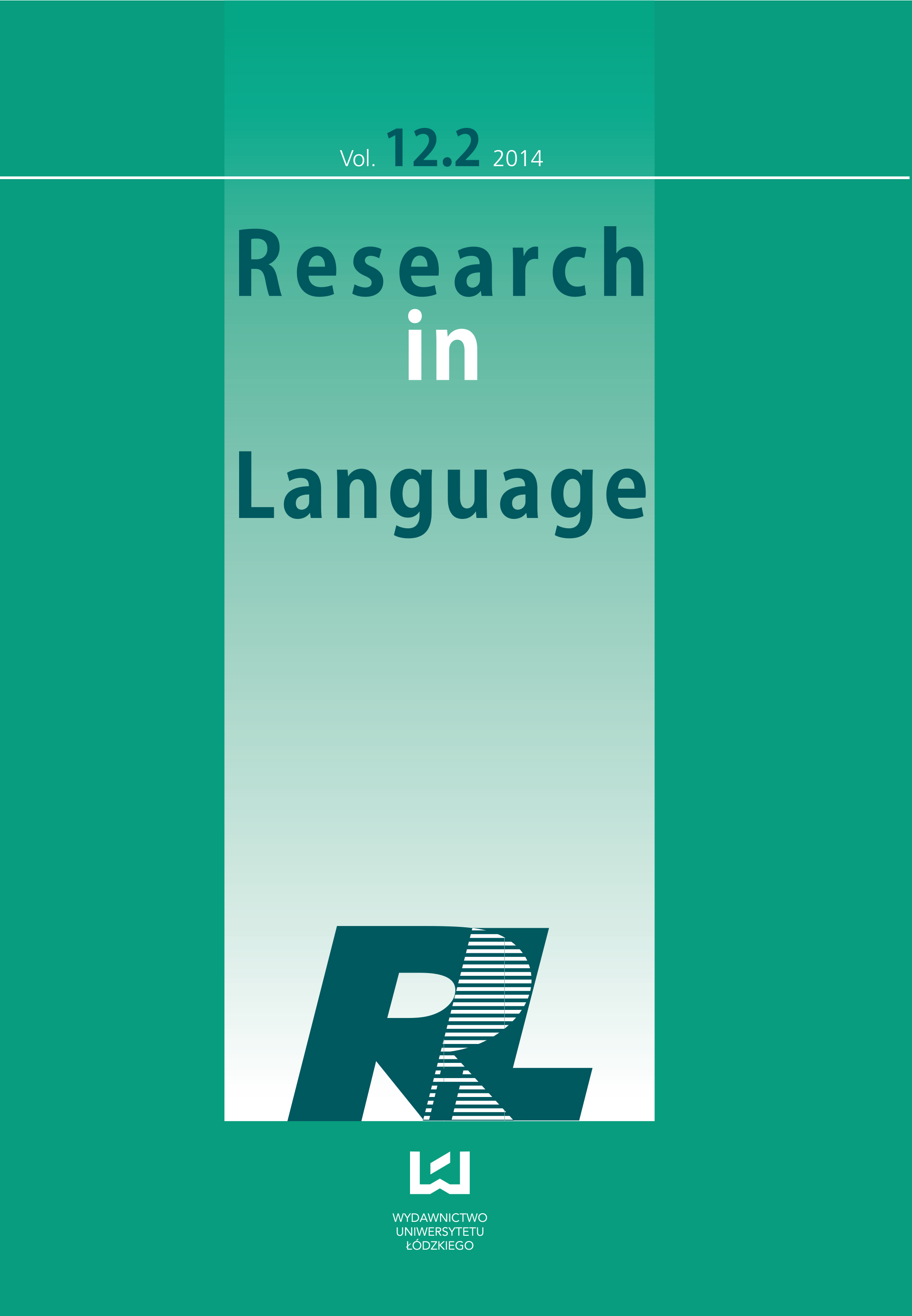Stop Release in Polish English — Implications for Prosodic Constituency
DOI:
https://doi.org/10.2478/rela-2014-0006Keywords:
coda stop release, L2 speech, phonetics-phonologyAbstract
Although there is little consensus on the relevance of non-contrastive allophonic processes in L2 speech acquisition, EFL pronunciation textbooks cover the suppression of stop release in coda position. The tendency for held stops in English is in stark opposition to a number of other languages, including Polish, in which plosive release is obligatory. This paper presents phonetic data on the acquisition of English unreleased stops by Polish learners. Results show that in addition to showing a tendency for the target language pattern of unreleased plosives, advanced learners may acquire more native-like VC formant transitions. From the functional perspective, languages with unreleased stops may be expected to have robust formant patterns on the final portion of the preceding vowel, which allow listeners to identify the final consonant when it lacks an audible release burst (see e.g. Wright 2004). From the perspective of syllabic positions, it may be said that ‘coda’ stops are obligatorily released in Polish, yet may be unreleased in English. Thus, the traditional term ‘coda’ is insufficient to describe the prosodic properties of post-vocalic stops in Polish and English. These differences may be captured in the Onset Prominence framework (Schwartz 2013). In languages with unreleased stops, the mechanism of submersion places post-vocalic stops at the bottom of the representational hierarchy where they may be subject to weakening. Submersion produces larger prosodic constituents and thus has phonological consequences beyond 'coda' behavior.
References
Arsenault, Paul. 2009. Coronal features and retroflexion in Dhivehi and other Indo-Aryan languages. Toronto Working Papers in Linguistics 30. 17–33.
Google Scholar
Bergier, M. 2010. The occurrence of unreleased oral stops in English voice agreeing plosive clusters straddling word boundaries. Production experiments with Polish advanced learners of English. M. A. Thesis. University of Silesia.
Google Scholar
Best, C. T. 1995. A direct realist perspective on cross-language speech perception. In W. Strange (Ed.), Speech perception and linguistic experience: Issues in cross-language research (pp. 171-204). Timonium, MD: York Press.
Google Scholar
Best, C. T., & Tyler, M. D. 2007. Nonnative and second-language speech perception: Commonalities and complementarities. In M. J. Munro & O.-S. Bohn (Eds), Second language speech learning – the role of language experience in speech perception and production (pp. 13-34). Amsterdam: John Benjamins.
Google Scholar
Boersma, P. & Weenink, D. 2011. Praat: doing phonetics by computer. [Computer program].Version 5.2.18.
Google Scholar
Bogacka, A. 2007. Repopulating vowel space: English diphthong production by Polish learners of English. PhD dissertation. Adam Mickiwicz University in Poznań.
Google Scholar
Cook, A. 2000. American Accent Training. Hauppauge, NY: Barron’s.
Google Scholar
Cruttenden, A. 2001. Gimson’s Pronunciation of English (6th ed.). London: Arnold.
Google Scholar
Dukiewicz, L. & I. Sawicka. 1995. Gramatyka współczesnego języka polskiego – fonetyka i fonologia [Grammar of modern Polish – phonetics and phonology]. Krakow: Wydawnictwo Instytutu Języka Polskiego PAN.
Google Scholar
Flege, J.E. 1995. Second language speech learning: Theory, findings, and problems. In W.Strange (Ed.), Speech perception and linguistic experience: Issues in cross-language research (pp. 233–277). Baltimore: York Press.
Google Scholar
Jenkins, J. 2000. The phonology of English as an international language. Oxford: Oxford University Press.
Google Scholar
Kahn, D. 1976. Syllable-based generalizations in English phonology. PhD dissertation, Massachusetts Institute of Technology.
Google Scholar
Kang, Y. 2003. Perceptual similarity in loanword adaptation: English post-vocalic word-final stops to Korean. Phonology 20 (2): 219-273.
Google Scholar
Kang, Y. 2011. Loanword phonology. In van Oostendorp, Marc, Colin Ewen, Elizabeth Hume, and Keren Rice, eds., Companion to Phonology. Wiley-Blackwell, pp. 2258-2282.
Google Scholar
Lindblom, B. 1990. Explaining phonetic variation: a sketch of the H&H theory. In Speech Production and Speech Modelling, edited by W. J. Hardcastle and A. Marchal (The Netherlands: Kluwer Academic), pp. 403-439.
Google Scholar
Rojczyk, A., A. Porzuczek & M. Bergier. 2013. Immediate and distracted imitation in second language speech: unreleased plosives in English. Research in Language 11.1. 3-18. DOI: 10.2478/v10015-012-0007-7
Google Scholar
Schwartz, G. 2013. A representational parameter for onsetless syllables. Journal of Linguistics, 49 (3), 613-646. DOI: http://dx.doi.org/10.1017/S0022226712000436
Google Scholar
Steriade, D. 1993. Closure, release, and nasal contours. In M. K. Huffman and R. A. Krakow (Eds.). Nasals, nasalization, and the velum (pp. 401−470). San Diego: Academic Press.
Google Scholar
Wright, R. 2004. Perceptual cue robustness and phonotactic constraints. In Hayes, B., R. Kirchner & D. Steriade (eds). Phonetically Based Phonology. Cambridge: Cambridge University Press, 34-57.
Google Scholar
Downloads
Published
How to Cite
Issue
Section
License

This work is licensed under a Creative Commons Attribution-NonCommercial-NoDerivatives 4.0 International License.










